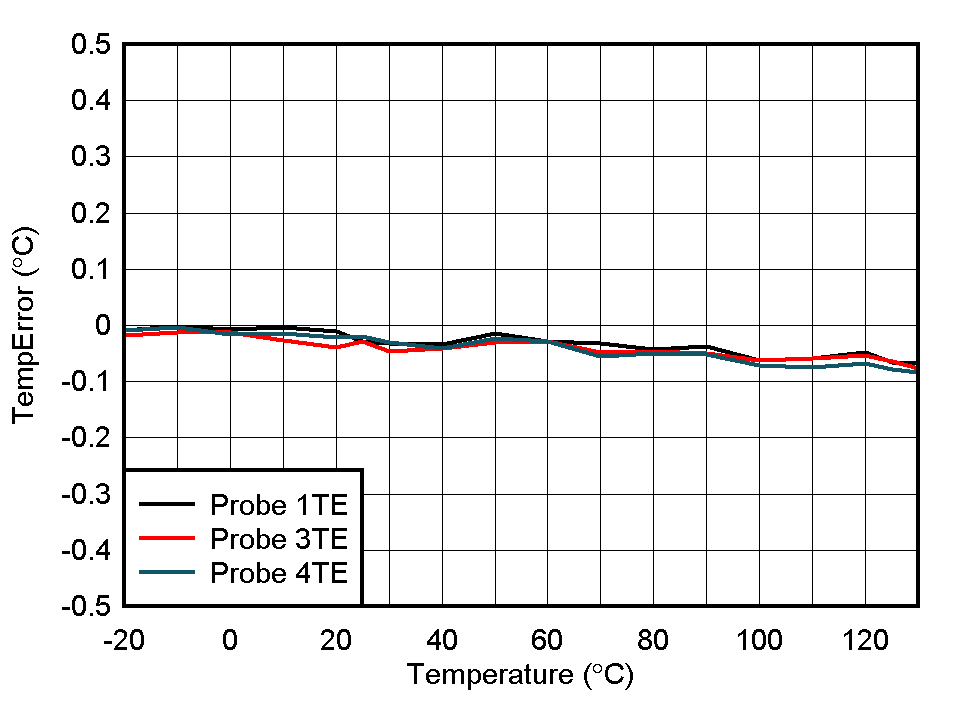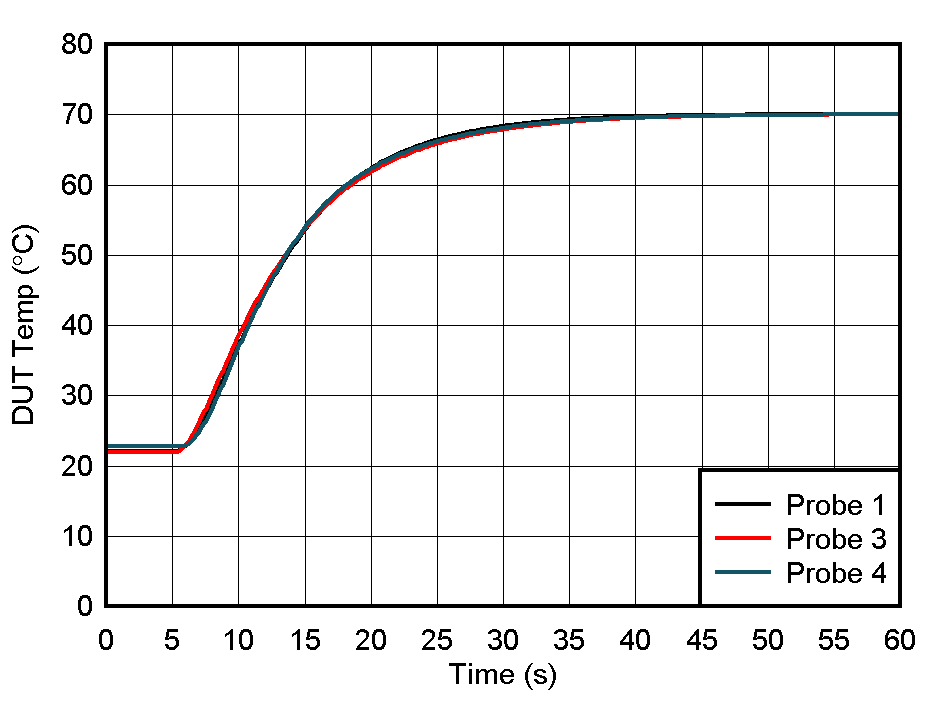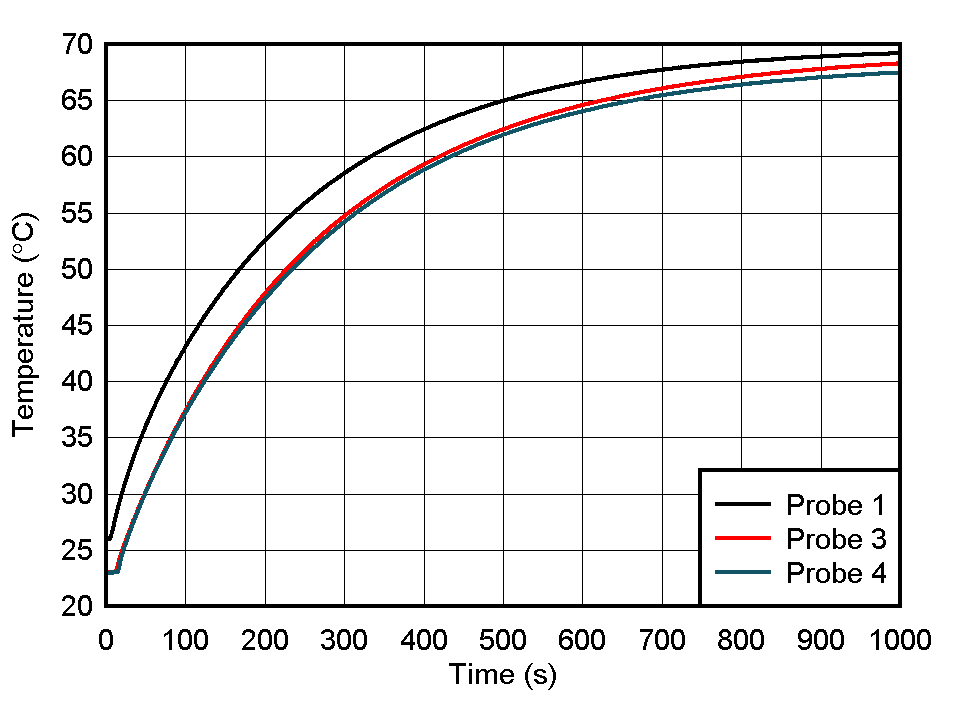TIDUEA0A March 2019 – September 2020
- Description
- Resources
- Features
- Applications
- 5
- 1System Description
- 2System Overview
-
3Hardware, Software, Testing Requirements, and Test Results
- 3.1 Required Hardware and Software
- 3.2
Testing and Results
- 3.2.1 Test Setup for Performance Testing
- 3.2.2 EMI and EMC Test Requirements for DRTD
- 3.2.3 TMP117 EMI/EMC Test Results
- 3.2.4 TMP117 Based Temperature Probe Measurement Performance Test Results
- 3.2.5 TMP116 Based Temperature Probe Measurement Performance Test Results
- 3.2.6 I2C-bus Cable Length Considerations
- 3.2.7 Power Supply
- 3.2.8 ESD Test Results for TMP116
- 3.2.9 Summary
- 4Design Files
- 5Software Files
- 6Related Documentation
- 7About the Author
- 8Revision History
3.2.4 TMP117 Based Temperature Probe Measurement Performance Test Results
For the following different test conditions, data is taken with the DRTD using both the TMP117 and TMP116 devices. The TMP117 is the recommended device due to the increased accuracy. However, since both temperature sensors will fit the application, data is shown for both. In this section, data was taken with 3 different TMP117 probes to ensure accurate results. See Section 3.2.5 for TMP116 probe results.
The DRTD probes were immersed into a precision Fluke oil bath with Galden HT200 oil, and ten values were read out for each temperature point. The measured range is from –20°C to 130°C in steps of 5 degrees C; the worst (largest) deviation from each of these ten values per step has been plotted for the respective temperature measurement point in Figure 3-5.
 Figure 3-5 TMP117 DRTD –20°C to 130°C
Temperature Error Drift.
Figure 3-5 TMP117 DRTD –20°C to 130°C
Temperature Error Drift. TI's DRTD achieves class AA accuracy.
The Class AA accuracy achieved with this TIDA-010002 DRTD unit without calibration is not ensured for all TMP117 devices by default. Due to the average ±3σ spread of the devices (see the TMP117x High-Accuracy, Low-Power, Digital Temperature Sensor With SMBus- and I2C-Compatible Interface Data Sheet), a single-point calibration is needed to minimize the temperature offset, either at 0°C using an ice bath or at room temperature, for example. Figure 3-5 shows that a DRTD probe with the TIDA-010002 inside can meet the Class AA limits for temperature offset without calibration. This is assuming the specific device performs close to the average curve shown in the data sheet.
EN60751:2008 requires that all RTDs are checked at one temperature point between –5°C and 30°C, preferably at 0°C. Class A and Class AA thermometers, which utilize the TIDA-010002, require a second check at a temperature of 90°C above the first one; this could be 0°C and 90°C or 3°C and 93°C, for example.
As the response time of the temperature sensor is an important parameter for standard RTDs, the TIDA-010002 performance was measured in stirred oil and still air for comparison. Stirred oil results are relevant for applications where the DRTD has direct contact with the fluid, as is the case with Heat and Cooling Meters. In Figure 3-6 the TMP117 DUT has an average initial temperature of 22°C and is inserted into a 70°C hot oil bath and the DUT reported temperature has been logged.
 Figure 3-6 TMP117 DRTD Response Time
in Stirred Oil Bath.
Figure 3-6 TMP117 DRTD Response Time
in Stirred Oil Bath.  Figure 3-7 TMP117 DRTD Response Time
in Still Air.
Figure 3-7 TMP117 DRTD Response Time
in Still Air.